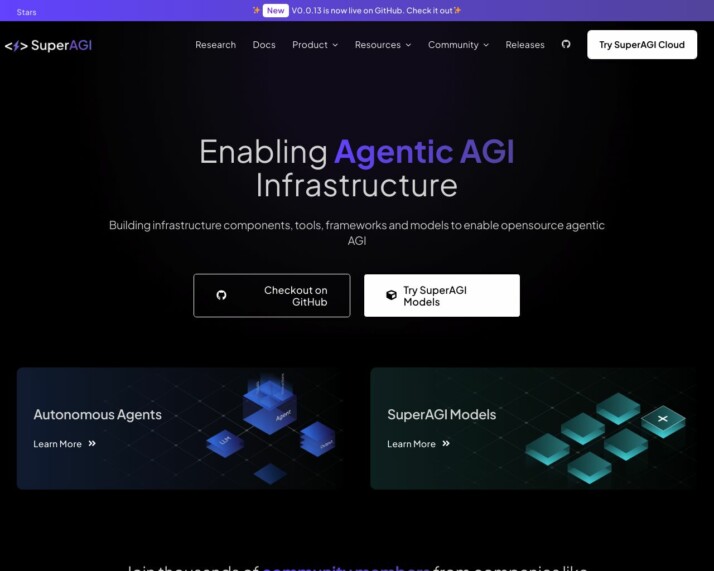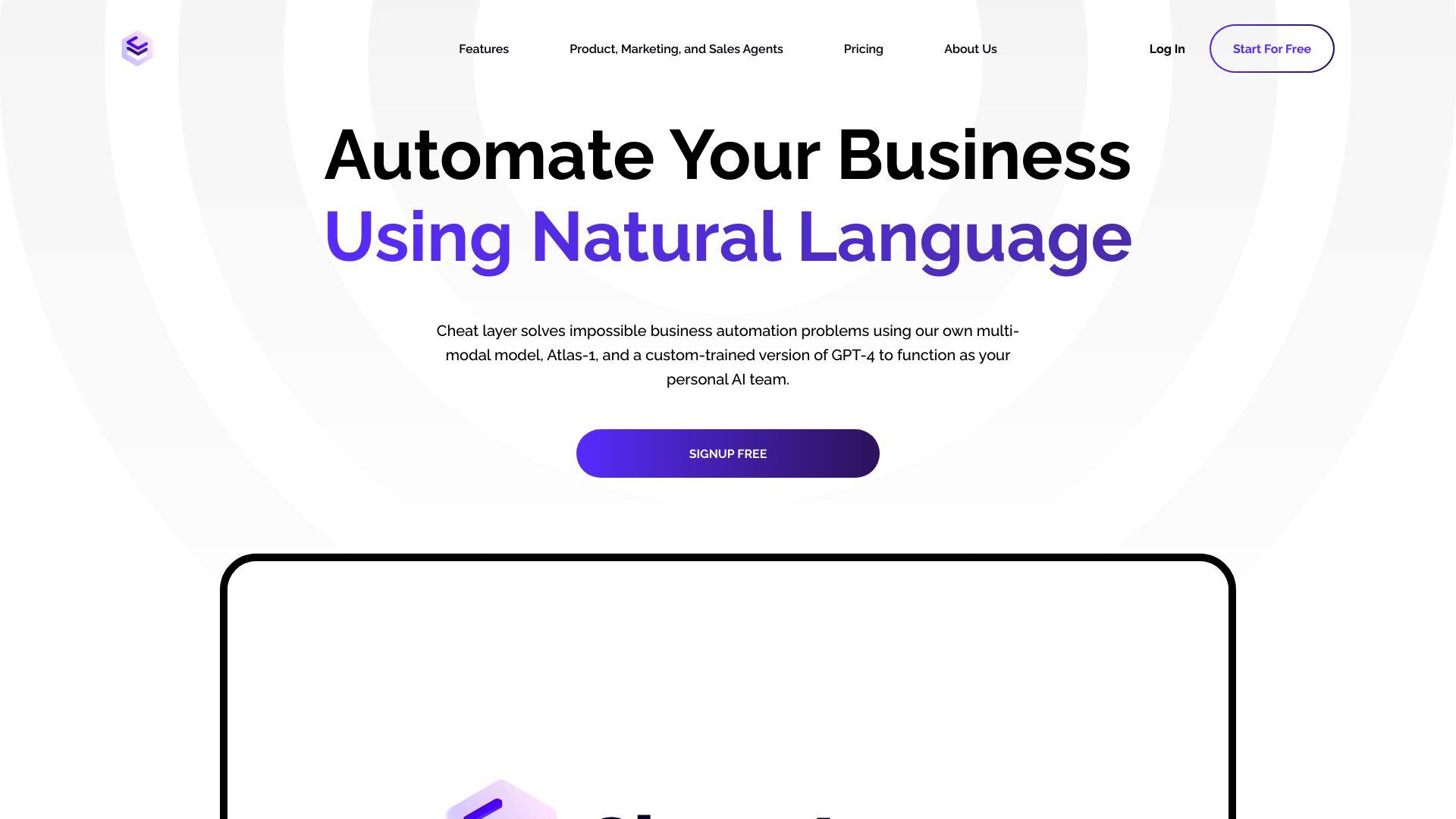SuperAGI vs. Cheat Layer: Comparing AI Automation Platforms
AI-powered automation platforms are transforming how businesses operate, with SuperAGI vs. Cheat Layer leading the charge in different ways. SuperAGI offers a powerful open-source framework for developers to create autonomous AI agents, while Cheat Layer simplifies business automation through natural language interactions. This comparison explores how these platforms stack up against SmythOS, a versatile AI solution that combines robust capabilities with user-friendly design. We’ll examine key features, use cases, and overall value to help you determine which platform best suits your AI automation needs, whether you’re a developer seeking advanced tools or a business user looking for accessible automation solutions.
SuperAGI Overview
SuperAGI offers an open-source autonomous AI agent framework that empowers developers to create, manage, and deploy intelligent agents. This platform leverages advanced technologies like Large Language Models (LLMs) and Large Action Models (LAMs) to enable the development of AI agents capable of performing complex tasks independently.
The framework excels in providing a comprehensive suite of tools for AI agent development. SuperAGI supports both development and production environments, allowing seamless transition from testing to deployment. Its robust feature set includes agent memory storage, performance monitoring, and integration with various tools such as Slack, GitHub, and Zapier. This versatility makes SuperAGI suitable for a wide range of applications, from automated software development to complex problem-solving tasks.


SuperAGI offers an open-source autonomous AI agent framework that empowers developers to create, manage, and deploy intelligent agents.
SuperAGI distinguishes itself through its focus on scalability and production-readiness. The platform supports concurrent agent execution, enabling multiple AI agents to work in parallel, significantly enhancing efficiency for large-scale operations. Its Docker-based installation simplifies setup, addressing common issues related to Python versioning and dependencies.
While SuperAGI offers powerful capabilities, it’s important to note that it primarily caters to users with technical expertise. The platform lacks a visual builder or no-code editor, which may present a steeper learning curve for non-technical users. However, for developers and organizations seeking to harness the power of autonomous AI agents, SuperAGI provides a robust foundation for creating sophisticated AI solutions.
The company behind SuperAGI demonstrates a strong commitment to advancing AI technology. Their research focuses on cutting-edge areas such as neurosymbolic AI, autonomous multi-agent systems, and recursive self-improvement systems. This dedication to innovation positions SuperAGI as a forward-thinking option for those looking to stay at the forefront of AI development.
Cheat Layer Overview
Cheat Layer revolutionizes business automation with its AI-powered platform. The software leverages a custom-trained GPT-4 model and Atlas-1, a multi-modal AI, to tackle complex automation challenges using natural language commands. This approach makes advanced automation accessible to users regardless of their technical expertise.
At the core of Cheat Layer’s offering is the Project Atlas Framework. This innovative system allows users to generate automations of unlimited complexity through simple conversations. By interacting with the AI as if speaking to an engineer, users can create end-to-end solutions without writing a single line of code. This natural language approach extends to Cheat Layer’s Semantic Targets feature, which ensures automations remain functional even when target services update their designs.
Cheat Layer revolutionizes business automation with its AI-powered platform … making advanced automation accessible to users regardless of their technical expertise.
Cheat Layer enhances productivity with its 1-Click Cloud Agents. These pre-built marketing and sales agents deploy directly from mobile devices, automating tasks like content creation, A/B testing, and lead generation with minimal setup. For iterative development, the Live Mode feature enables real-time feedback on products such as apps and landing pages, ensuring outputs align with intended goals.


The platform’s no-code interface features a drag-and-drop editor, making automation creation accessible to users without programming knowledge. This democratization of automation technology aligns with Cheat Layer’s vision of leveling the playing field for small businesses, allowing them to compete with larger firms using powerful, cost-effective automation tools.
The platform’s no-code interface … aligns with Cheat Layer’s vision of leveling the playing field for small businesses, allowing them to compete with larger firms using powerful, cost-effective automation tools.
Cheat Layer also caters to agencies with its white-label solutions. This feature enables the creation and resale of custom automation solutions as branded Chrome extensions, opening new revenue streams for service providers.
While Cheat Layer offers a compelling suite of features, potential users should consider their specific needs and technical capabilities when evaluating the platform. The reliance on natural language processing for complex automations may require a learning curve to fully leverage the system’s potential. Additionally, as with any cloud-based solution, users should assess the platform’s scalability and integration capabilities within their existing tech stack.
Feature Comparison
SuperAGI and Cheat Layer offer distinct approaches to AI agent development, each with its own strengths and limitations. SuperAGI provides a robust, open-source framework for creating autonomous AI agents, while Cheat Layer focuses on simplifying business automation through natural language interactions.
SuperAGI excels in its support for autonomous agents, offering features like agent memory storage and multi-agent collaboration. These capabilities enable developers to create sophisticated AI systems capable of complex problem-solving and independent decision-making. However, SuperAGI lacks a visual builder or no-code editor, which may present challenges for users without extensive technical expertise.
In contrast, Cheat Layer emphasizes accessibility with its natural language approach and no-code interface. The platform’s Project Atlas Framework allows users to generate complex automations through simple conversations, making advanced AI capabilities available to a broader audience. While this approach simplifies the creation process, it may limit the depth of customization compared to SuperAGI’s more developer-centric framework.
Feature Comparison Table
| SuperAGI | Cheat Layer | SmythOS | |
|---|---|---|---|
| CORE FEATURES | |||
| Visual Builder | ❌ | ✅ | ✅ |
| No-Code Options | ❌ | ✅ | ✅ |
| SECURITY | |||
| IP Control | ❌ | ❌ | ✅ |
| COMPONENTS | |||
| Huggingface AIs | ✅ | ❌ | ✅ |
| Data Lakes | ❌ | ❌ | ✅ |
| DEPLOYMENT OPTIONS (EMBODIMENTS) | |||
| Staging Domains | ❌ | ✅ | ✅ |
| DATA LAKE SUPPORT | |||
| Hosted Vector Database | ✅ | ❌ | ✅ |
| Sitemap Crawler | ❌ | ✅ | ✅ |
| YouTube Transcript Crawler | ❌ | ✅ | ✅ |
Best Alternative to SuperAGI and Cheat Layer
SmythOS emerges as the superior alternative to SuperAGI and Cheat Layer, offering a comprehensive and user-friendly platform for creating and deploying AI agents. Our solution combines the best of both worlds, providing the robust capabilities of SuperAGI with the accessibility of Cheat Layer, while surpassing both in terms of features and ease of use.
We designed SmythOS with a powerful drag-and-drop interface, enabling users to build complex AI workflows without extensive coding knowledge. This visual approach democratizes AI development, making it accessible to a broader audience while still offering the depth and flexibility that experienced developers demand.
SmythOS emerges as the superior alternative to SuperAGI and Cheat Layer, offering a comprehensive and user-friendly platform for creating and deploying AI agents.
Unlike SuperAGI, which lacks a visual builder, and Cheat Layer, which focuses primarily on natural language interactions, SmythOS provides a versatile toolkit for creating sophisticated AI agents. Our platform supports a wide range of AI models, including those from OpenAI, Anthropic, and Hugging Face, giving users the flexibility to choose the best foundation for their specific needs.
SmythOS excels in its extensive integration ecosystem, supporting connections to popular services like Slack, Trello, and GitHub. This flexibility ensures that our AI agents can seamlessly fit into virtually any workflow or business process. Additionally, we offer pre-built API integrations and templates, significantly reducing setup time and allowing users to focus on innovation rather than implementation details.
Our platform’s multi-agent orchestration capabilities set it apart from both SuperAGI and Cheat Layer. SmythOS enables the creation of collaborative AI systems, where multiple agents work together on complex tasks, enhancing efficiency and scalability. This feature, combined with our advanced deployment options across various cloud platforms and as chatbots or Alexa skills, provides unparalleled versatility for integrating AI solutions into existing systems.
Conclusion
SuperAGI and Cheat Layer offer unique approaches to AI agent development and automation, but SmythOS emerges as the superior choice for businesses seeking a comprehensive, user-friendly AI solution. SuperAGI provides a robust open-source framework for creating autonomous AI agents, ideal for developers with technical expertise. Cheat Layer simplifies business automation through natural language interactions, making it accessible to non-technical users. However, SmythOS combines the best of both worlds and adds significant value.
SmythOS stands out with its intuitive drag-and-drop interface, enabling users to create complex AI workflows without extensive coding knowledge. This democratization of AI development makes it accessible to a broader audience, from technical teams to business users. The platform’s extensive integration ecosystem, supporting over 300,000 integrations, allows seamless connection to various data sources, APIs, and AI models, fitting into virtually any workflow or business process.
Unlike its competitors, SmythOS offers unparalleled versatility in deployment options. Users can deploy AI agents across multiple platforms, including Google Vertex, Microsoft Copilot, and Amazon Web Services Bedrock, as well as chatbots, APIs, and scheduled agents. This ’Create Once, Deploy Anywhere’ approach significantly enhances the scalability and adaptability of AI solutions in diverse business environments.
To experience the power of SmythOS firsthand, create a free account and start building AI agents with no time limit. For those looking to dive deeper into the platform’s capabilities, explore our comprehensive documentation or check out our diverse range of AI-powered agent templates to jumpstart your AI journey. SmythOS is not just a tool; it’s a gateway to revolutionizing your business processes with cutting-edge AI technology.
Last updated:
Disclaimer: The information presented in this article is for general informational purposes only and is provided as is. While we strive to keep the content up-to-date and accurate, we make no representations or warranties of any kind, express or implied, about the completeness, accuracy, reliability, suitability, or availability of the information contained in this article.
Any reliance you place on such information is strictly at your own risk. We reserve the right to make additions, deletions, or modifications to the contents of this article at any time without prior notice.
In no event will we be liable for any loss or damage including without limitation, indirect or consequential loss or damage, or any loss or damage whatsoever arising from loss of data, profits, or any other loss not specified herein arising out of, or in connection with, the use of this article.
Despite our best efforts, this article may contain oversights, errors, or omissions. If you notice any inaccuracies or have concerns about the content, please report them through our content feedback form. Your input helps us maintain the quality and reliability of our information.
